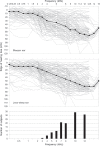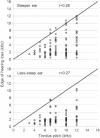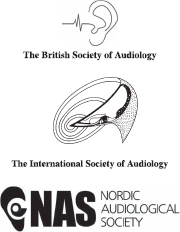Relationship between tinnitus pitch and edge of hearing loss in individuals with a narrow tinnitus bandwidth
- PMID: 25470623
- PMCID: PMC4438350
- DOI: 10.3109/14992027.2014.979373
Relationship between tinnitus pitch and edge of hearing loss in individuals with a narrow tinnitus bandwidth
Abstract
Objective: Psychoacoustic measures of tinnitus, in particular dominant tinnitus pitch and its relationship to the shape of the audiogram, are important in determining and verifying pathophysiological mechanisms of the condition. Our previous study postulated that this relationship might vary between different groups of people with tinnitus. For a small subset of participants with narrow tinnitus bandwidth, pitch was associated with the audiometric edge, consistent with the tonotopic reorganization theory. The current study objective was to establish this relationship in an independent sample.
Design: This was a retrospective design using data from five studies conducted between 2008 and 2013.
Study sample: From a cohort of 380 participants, a subgroup group of 129 with narrow tinnitus bandwidth were selected.
Results: Tinnitus pitch generally fell within the area of hearing loss. There was a statistically significant correlation between dominant tinnitus pitch and edge frequency; higher edge frequency being associated with higher dominant tinnitus pitch. However, similar to our previous study, for the majority of participants pitch was more than an octave above the edge frequency.
Conclusions: The findings did not support our prediction and are therefore not consistent with the reorganization theory postulating tinnitus pitch to correspond to the audiometric edge.
Trial registration: ClinicalTrials.gov NCT02095262.
Keywords: Audiogram; audiometric edge; multiple regression; narrow bandwidth; tinnitus pitch.
Figures





References
-
- Baguley D., McFerran D., Hall D.A. Tinnitus. The Lancet. 2013;382:1600–1607. - PubMed
-
- Borg G., Borg E. A new generation of scaling methods: Level anchored ratio scaling. Psychologica. 2001;28:15–45.
-
- Eggermont J.J., Roberts L.E. The neuroscience of tinnitus. Trends Neurosci. 2004;27:676–682. - PubMed
-
- Heijneman K.M., de Kleine E., Wiersing-Post E., van Dijk P. Can the tinnitus spectrum identify tinnitus subgroups? Noise Health. 2013;15:101–106. - PubMed
Publication types
MeSH terms
Associated data
LinkOut - more resources
Full Text Sources
Other Literature Sources
Medical
